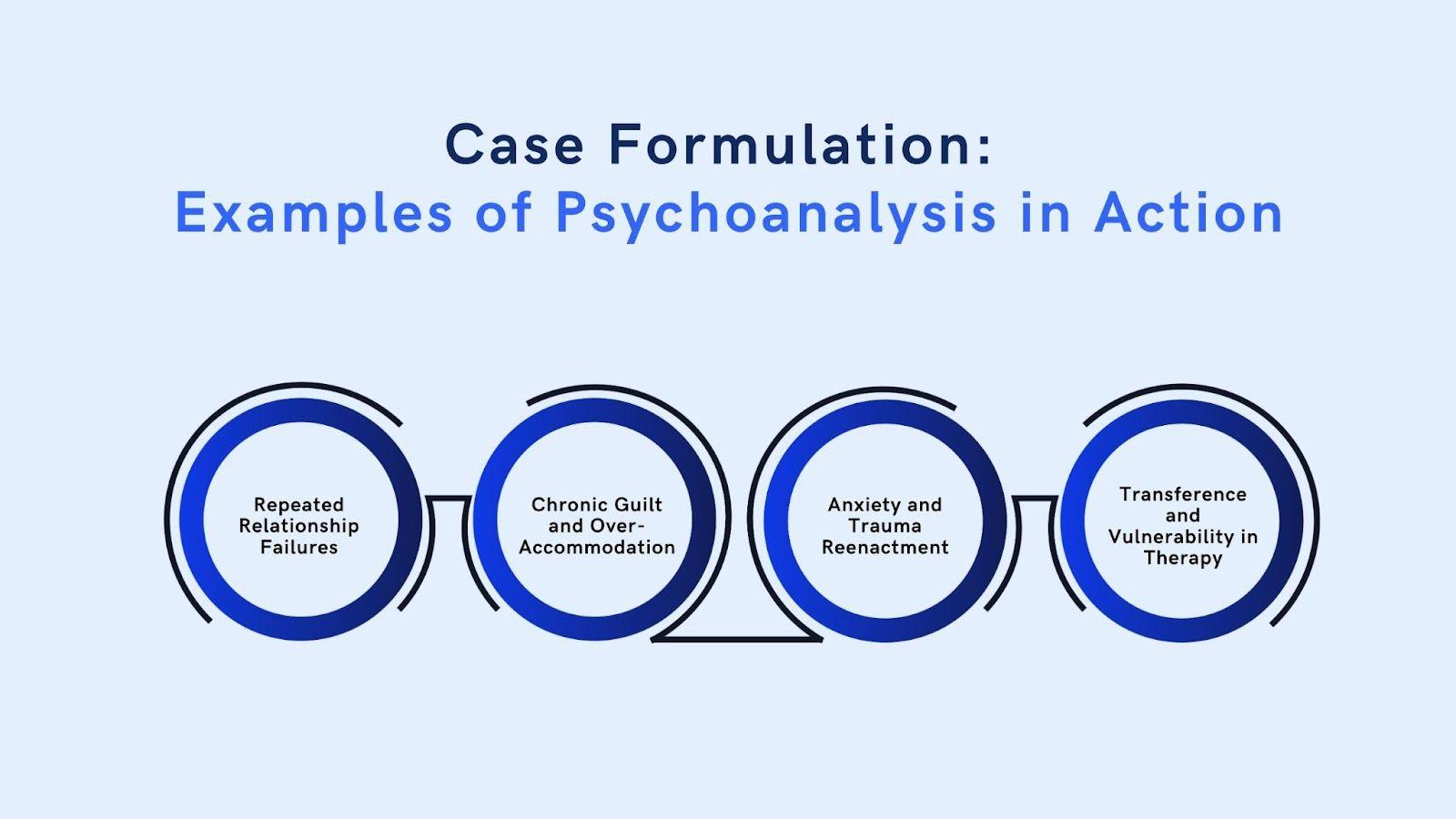
19 March 2025
Recurrent Patterns in Behavior: A Psychoanalytic Framework for Mental Health Professionals
Did you know? 7.8% of the world’s population struggles with personality disorders.
As mental health specialists, you’ve likely encountered clients with these disorders whose behaviours seem to follow recurring, often self-defeating patterns. Despite their best efforts to change, these clients find themselves repeating the same cycles—whether in relationships, work, or personal habits.
Understanding these patterns often requires understanding beyond surface-level symptoms to uncover the unconscious conflicts and early experiences driving them. In this article, we shall explore the practical psychoanalytic case formulation and some of the best examples that you can refer to. But before we begin, let’s understand the basics.
What is Psychoanalysis? A Theoretical Foundation
“Psychoanalysis, rooted in the pioneering work of Sigmund Freud, offers a rich theoretical framework for understanding human behaviour.” Freud’s theory says that the psyche consists of three interacting systems:
- The Id: This represents primal desires and drives, mainly for pleasure and survival.
- The Ego: This mediates between the id, superego, and external reality, balancing impulses and societal expectations.
- The Superego: This acts as an internalised moral compass influenced by cultural norms and parental authority.
Central to psychoanalysis is the idea that much of our psychological life operates below conscious awareness. The unconscious mind holds repressed thoughts, emotions, and memories, which influence present behaviour and mental health.
Key mechanisms, such as defence mechanisms (e.g., repression, denial, projection), help individuals manage anxiety but often perpetuate unresolved conflicts.
Freud emphasised the importance of early relationships, particularly with primary caregivers, in shaping the individual’s psyche. Experiences during formative years establish patterns of attachment, emotional regulation, and self-perception. These patterns often persist into adulthood, manifesting in interpersonal dynamics, emotional responses, and coping strategies.
Psychoanalysis aims to uncover these unconscious processes through techniques such as free association, dream analysis, and exploration of transference. By bringing unconscious material into conscious awareness, your clients can gain insight into the root causes of their distress and develop healthier ways of thinking, feeling, and relating.
The Psychoanalytic Case Formulation Process

Psychoanalytic case formulation is both an art and a science. It involves integrating your client’s life history, presenting symptoms, and unconscious processes into a cohesive understanding of their difficulties. This formulation provides a roadmap for intervention and therapeutic goals.
Key Components of Psychoanalytic Case Formulation
1. Life History and Developmental Milestones
- Early attachments and parental relationships.
- Childhood traumas or disruptions in emotional development.
- Critical life events that shaped identity and coping mechanisms.
2. Unconscious Conflicts
- Internal tensions between desires, fears, and prohibitions.
- Manifestations of these conflicts in symptoms, dreams, and defences.
3. Defence Mechanisms: Adaptive or maladaptive strategies are used to manage anxiety or psychic pain, like repression, denial, projection, and intellectualisation.
4. Transference and Countertransference: Relational dynamics in therapy as reflections of unresolved conflicts.
Case Formulation: Examples of Psychoanalysis in Action

Psychoanalytic case formulation involves creating a narrative that connects your client’s symptoms, unconscious conflicts, and early life experiences. By examining recurring patterns and defences, you uncover the more profound issues driving distress. Below, we explore detailed examples to illustrate how psychoanalysis interprets symptoms and formulates treatment plans.
1. Repeated Relationship Failures
Presenting a Problem: A 35-year-old client named John seeks therapy due to repeated breakups, with partners often accusing them of being emotionally unavailable. He expresses confusion and frustration, believing that he is trying his best to make relationships work.
Psychoanalytic Understanding:
- Early Experiences: John grew up with emotionally distant parents and family members who discouraged vulnerability. These early relationships taught him that expressing emotions was unsafe, leading to a fear of closeness.
- Unconscious Conflict: John also has a strong desire for intimacy but an equally strong fear of rejection. This internal conflict manifests in relationships, where he unconsciously distances himself to avoid potential hurt.
- Defence Mechanism: Emotional detachment serves as a protective barrier, allowing him to avoid feelings of vulnerability or inadequacy.
Intervention:
You can use transference dynamics to work with clients like John to explore the origins of their fear of intimacy.
For example, when your client begins to see you as emotionally unavailable, you can gently interpret this perception as a projection of their unmet needs from childhood. Over time, the client learns to tolerate vulnerability and develop healthier relational patterns.
2. Chronic Guilt and Over-Accommodation
Presenting another Problem: A 42-year-old client named Sarah reports feeling overwhelmed by chronic guilt and an inability to set boundaries. She often overextends herself in relationships, prioritising others' needs at the expense of her own.
Psychoanalytic Understanding:
- Early Experiences: Sarah was the oldest child in a family with frequent parental conflict. She often played the role of a mediator, believing that her responsibility was to maintain harmony in the family.
- Unconscious Conflict: Sarah’s desire for autonomy clashes with an internalised belief that her worth is tied to self-sacrifice. This dynamic perpetuates feelings of guilt whenever she prioritises her own needs.
- Defence Mechanism: Over-accommodation acts as a defence, allowing Sarah to avoid the anxiety associated with perceived selfishness or rejection.
Intervention:
You can help your clients like Sarah to recognise how their childhood role as a caretaker continues to shape their behaviour. By examining these unconscious patterns, your client begins to question the necessity of self-sacrifice for maintaining relationships. You can support your client to develop healthier boundaries and address their fear of conflict.
3. Anxiety and Trauma Reenactment
Presenting the Problem: A 28-year-old client named Emma experiences recurring panic attacks, often triggered by crowded spaces. Despite recognising that her fear is disproportionate, she feels powerless to control her reactions.
Psychoanalytic Understanding:
- Early Experiences: Emma recalls a traumatic childhood event in which she got separated from her parents in a crowded mall at the age of 8. While she consciously believes the event is “in the past,” the emotional impact remains unresolved.
- Unconscious Conflict: Emma’s psyche associates crowded spaces with feelings of abandonment and helplessness. This unresolved trauma continues to influence her responses despite being repressed on a conscious level.
- Defence Mechanism: Avoidance of crowded spaces is a defence against reliving the overwhelming emotions associated with the trauma in the case of Emma.
Intervention:
You can use free association and dream analysis to help your clients like Emma access repressed feelings of fear and helplessness. Through gradual exposure and interpretation, your client will be encouraged to process these emotions, weakening their hold on the present. Over time, your client develops greater resilience and the ability to tolerate situations that previously triggered panic.
4. Transference and Vulnerability in Therapy
Presenting the Problem: A 30-year-old client named Jessica initially seeks therapy for work-related stress but begins displaying intense emotional reactions toward you, alternating between idealisation and frustration.
Psychoanalytic Understanding:
- Early Experiences: Jessica’s parent was inconsistent, offering affection sporadically and withdrawing it as punishment. This created a deep-seated fear of abandonment alongside a longing for unconditional support.
- Unconscious Conflict: In the therapeutic relationship, Jessica re-enacts her early attachment dynamic, projecting unresolved needs and fears onto you, the therapist.
- Defence Mechanism: Jessica’s oscillation between idealisation and frustration reflects an unconscious effort to test your reliability, mirroring their childhood attempts to secure parental attention.
Intervention:
You acknowledge the transference dynamic, helping your clients like Jessica understand how their emotional reactions in therapy reflect unresolved childhood experiences. By consistently responding with empathy and reliability, you can support them to create a corrective emotional experience, allowing the client to internalise a healthier model of relationships.
Integrating Case Examples into Psychoanalytic Practice
These case examples demonstrate how psychoanalysis provides a structured framework for understanding complex psychological dynamics. By integrating early experiences, unconscious conflicts, and defence mechanisms into a cohesive narrative, therapists can:
- Identify the root causes of distress rather than merely addressing symptoms.
- Tailor interventions that target the underlying dynamics maintaining psychological difficulties.
- Foster long-term change by helping clients develop insight into their unconscious patterns.
Psychoanalytic case formulation is not a rigid process but an evolving narrative that deepens as therapy progresses. By combining careful observation with theoretical knowledge, mental health specialists can guide clients toward greater self-awareness and emotional freedom.
Frequently Asked Questions (FAQs)
1.What is psychoanalysis, and how does it help in understanding recurring behavioural patterns?
Psychoanalysis is a therapeutic approach rooted in Sigmund Freud's theories. It explores unconscious conflicts, early life experiences, and defence mechanisms that shape behaviours. By uncovering these unconscious processes, psychoanalysis helps clients understand the root causes of recurring patterns and fosters healthier ways of thinking and behaving.
2. What role does early childhood experience play in shaping recurring behaviours?
Early experiences, especially relationships with primary caregivers, significantly influence attachment styles, emotional regulation, and self-perception. These experiences create unconscious patterns that persist into adulthood, impacting relationships, emotional responses, and coping mechanisms.
3. What are some common defence mechanisms, and how do they impact behaviour?
Defence mechanisms like repression, denial, projection, and over-accommodation are strategies individuals unconsciously use to manage anxiety or distress. While they can offer temporary relief, these mechanisms often perpetuate unresolved conflicts and contribute to recurring, self-defeating behaviours.
4. How does psychoanalytic case formulation work in therapy?
Psychoanalytic case formulation integrates a client’s life history, symptoms, unconscious processes, and relational dynamics into a cohesive understanding of their difficulties. It helps therapists identify the root causes of distress and design targeted interventions for lasting change.
5. What is transference, and why is it important in psychoanalytic therapy?
Transference occurs when clients project unresolved feelings and expectations from past relationships onto their therapist. It provides valuable insight into unconscious conflicts and early attachment patterns. Therapists use this dynamic to help clients understand and work through unresolved issues.
6. How can psychoanalysis help with recurring relationship or emotional issues?
By exploring unconscious conflicts and early experiences, psychoanalysis uncovers the deeper reasons behind recurring issues, such as fear of intimacy or chronic guilt. Through techniques like free association and interpretation of transference, clients gain insights and develop healthier behaviours, breaking the cycle of self-defeating patterns.
Conclusion
Psychoanalysis offers a profound and nuanced approach to understanding human behaviour, emphasising the importance of the unconscious mind, early experiences, and defence mechanisms. As mental health specialists, integrating psychoanalytic principles and case formulation into your practice allows you to uncover the hidden roots of your clients’ distress.
This process not only provides deeper insight into their recurring patterns and unconscious conflicts but also equips you to develop personalised interventions that promote meaningful, lasting change. Using PractaLuma’s Automated Report Writing and Clinical Note Generation, you can save time and energy on tedious note-making and spend more time helping your clients with psychoanalytical case formulation. Check out PractaLuma here.